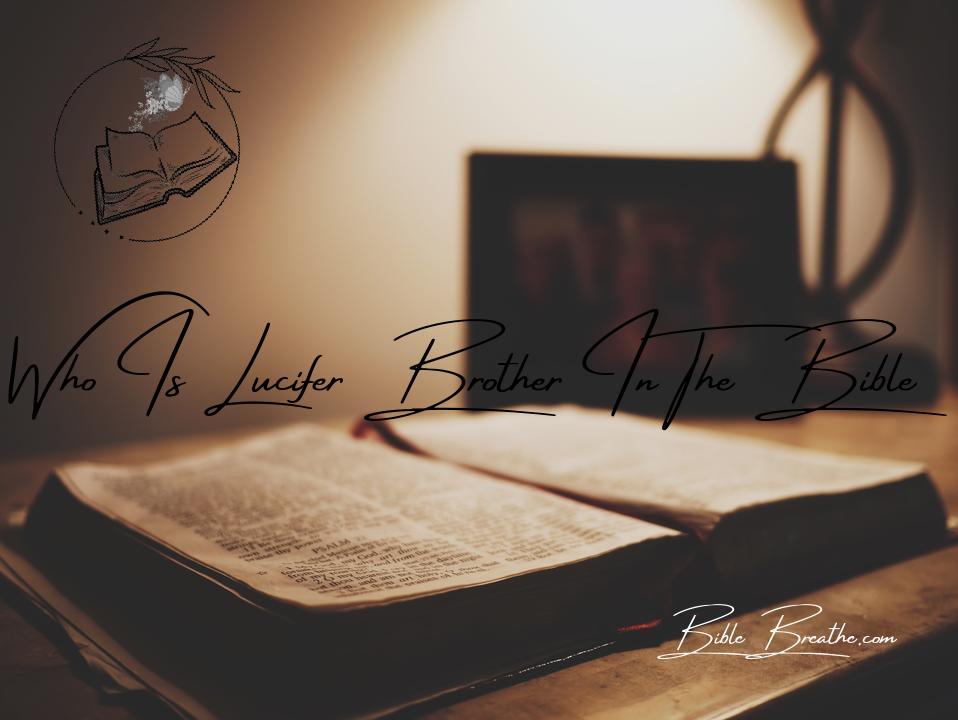Ever wondered who’s rollin’ in the heavenly realm with Lucifer?
Well, folks, you’re in for a celestial ride today!
We’re peeling back the angelic layers to reveal the cosmic drama.
We’ve got Satan, formerly known as Lucifer, as our main character.
Now, picture him in a divine face-off with none other than Archangel Michael, like two heavyweights in the spiritual ring.
You see, there’s a whole angelic hierarchy thing going on up there, with stars like Archangel Gabriel sharing the stage.
But Lucifer’s pride shook the heavens, and down he tumbled, becoming that “Light Bringer” we all know.
This isn’t just a sibling squabble; it’s a cosmic clash of epic proportions.
We’re talkin’ redemption, temptation, sin, and the eternal showdown between good and evil.
Buckle up, my friends!
We’re diving into the celestial saga that unveils Lucifer’s brother and the epic cosmic battle that’s shaped our faith for centuries.
🌟
Key Takeaways
-
It’s crucial to distinguish between biblical accounts and modern interpretations when discussing Lucifer and his relationship with other angels. In the Bible, Lucifer is not explicitly identified as having a brother. The concept of Lucifer as a fallen angel primarily stems from interpretations of passages in the Book of Isaiah and the Book of Ezekiel, where a figure described as the “morning star” is often associated with pride and rebellion.
-
The complex nature of angelic relationships in religious texts is evident in the limited information provided in the Bible. While some passages allude to angels’ roles and interactions, they do not delve into detailed family relationships among angels. The Bible focuses on conveying spiritual and moral messages rather than providing exhaustive details about the angelic realm.
-
The influence of biblical characters, such as Lucifer, continues to be felt in contemporary culture. Lucifer has become a symbolic figure representing rebellion, temptation, and the fall from grace in various literary and artistic works. Understanding the biblical origins of such characters is essential for a nuanced interpretation of their portrayal in modern media and literature.
-
In conclusion, when exploring the identity of Lucifer’s brother in the Bible, it’s important to recognize the distinction between biblical accounts and modern interpretations. The complexity of angelic relationships in religious texts underscores the need for cautious interpretation. Additionally, the enduring influence of biblical characters like Lucifer in contemporary culture highlights the ongoing relevance of these ancient narratives in shaping our understanding of morality and spirituality.
Unveiling the Mysterious Figure of Lucifer

Photo modified by BibleBreathe.com. Original photo by Joseph Vogel on Pexels
Lucifer, oh boy, that’s a name that rings out in the halls of biblical tales like a thunderclap on a stormy night.
Let’s take a stroll into the enigmatic world of Lucifer, uncovering the shadows that surround him and the remarkable journey from heavenly radiance to the embodiment of darkness.
Cracking Open the Origin of the Name “Lucifer”
To unravel the enigma of Lucifer, we’ve got to start with his name.
The word “Lucifer” dances its origins in Latin, giving us a peek into its essence: “light-bringer” or “morning star.”
Picture it like the star that struts its stuff in the early morning sky.
But hold on, the sparkle dimmed.
Lucifer’s Starring Role in Biblical Chronicles
Now, diving into the Bible’s script, we find Lucifer hogging the limelight as a celestial VIP.
This fella held a high and mighty position in the heavenly gang, often depicted as a dazzling force.
“How art thou fallen from heaven, O Lucifer, son of the morning! how art thou cut down to the ground, which didst weaken the nations!” – Isaiah 14:12 (KJV)
Isaiah’s words spill the beans on Lucifer’s nosedive from the celestial stage, going from heavenly heights to rock bottom.
But why the fall?
What set off this celestial fireworks show, plunging him from grace to gloom?
The Big Change from Lucifer to Satan
The plot twist of Lucifer becoming Satan is like a plot straight out of an epic saga.
It’s a tale of rebellion, pride, and the ultimate showdown between good and evil.
Picture Lucifer wanting the big chair and defying the heavenly boss, leading to his eviction from the ultimate mansion and his transformation into Satan, the ultimate rival of God and humanity.
“And there was war in heaven: Michael and his angels fought against the dragon; and the dragon fought and his angels, And prevailed not; neither was their place found any more in heaven.” – Revelation 12:7-8 (KJV)
This celestial clash between the archangel Michael and Lucifer, now wearing the Satan cape, showcases the consequences of pride and disobedience.
It’s a blazing cautionary tale, reminding us to keep it real with humility and obey the boss up above.
In the upcoming chapters, we’ll keep digging into the aftermath of Lucifer’s celestial nosedive, his gig as Satan, and what this dramatic rebellion means for us earthly beings and the realms beyond.
Stay tuned!
🌟
The Celestial Showdown: Lucifer and the Warrior Archangel

Photo modified by BibleBreathe.com. Original photo by Craig Adderley on Pexels
Oh, let’s talk about a showdown that makes a Marvel movie seem like child’s play!
The Bible paints a cosmic mural, a tale that echoes through time.
And in this celestial drama, you might wonder, “Who’s Lucifer’s brother in this divine narrative?”
The Brightest Angel Falls
To get this, we gotta rewind a bit and dig into why Lucifer took a nosedive from grace.
This dude was an archangel, the epitome of heavenly splendor.
But guess what?
His pride got the best of him.
He wanted to outshine God, if you can imagine that!
Rebellion was his jam, and that didn’t bode well.
In this clash of titans, enter Archangel Michael.
Picture this dude like a celestial action hero, standing up against Lucifer’s rebellion.
It was the ultimate face-off, representing the eternal tussle of good versus evil.
“How art thou fallen from heaven, O Lucifer, son of the morning!” – Isaiah 14:12 (KJV)
Ripple Effect on Us Earthlings
Now, Lucifer’s choices had repercussions beyond the heavenly scene.
He got booted out of heaven, morphing into the infamous Satan. The tempter, the epitome of evil, the one pointing fingers at humanity.
This rebellion set the stage for our human drama.
Remember that snake tempting Adam and Eve in the garden, nudging them towards that forbidden fruit?
Yep, that was Lucifer.
It kickstarted our journey of wrestling with sin and seeking redemption.
Lucifer’s fall and his brother, Archangel Michael, are like a divine action movie.
It’s a tale of celestial beings, choices, and a constant tug-of-war between light and darkness.
In the grand biblical mural, Lucifer’s fall is a game-changer.
His mysterious brother, Archangel Michael, symbolizes the epic struggle between good and evil.
This story’s a masterpiece, urging us to reflect on redemption, temptation, and the enduring grace of faith.
Let that sink in, my friend.
🌟
Unraveling the Mystery of Lucifer’s Cosmic Connections

Photo modified by BibleBreathe.com. Original photo by Josh Willink on Pexels
Ah, the cosmic dance of celestial beings, it’s like trying to unravel the threads of fate in a grand tapestry.
Folks often wonder about the connection between Lucifer and Archangel Michael, asking if they’re celestial siblings.
Well, let’s grab our magnifying glasses and get to the bottom of this puzzler, setting straight some notions that’ve made their way into today’s media whirlwind.
Peering into the Relationship of Lucifer and Archangel Michael
The notion of Lucifer and Archangel Michael being brothers sprouts from the angelic hierarchy described in the Bible.
While the Good Book doesn’t exactly scream “sibling rivalry,” it does paint them as major players in the heavenly scene, each with their unique gig.
Archangel Michael gets cast as the warrior angel, the guardian of what’s right, and the shield-bearer for God’s crew.
On the flip side, Lucifer, as we chatted about earlier, was a top-tier angel who pulled a rebellious stunt, crashed and burned, and emerged as Satan.
Their paths went in opposite directions faster than a race car on a straight track.
Though they might not be kin in the traditional sense, their tales are braided together in a way that could rival any family saga.
Their showdown in the cosmic ring, as shown in the Book of Revelation, is like the ultimate heavyweight championship, symbolizing the age-old clash between good and evil.
Sorting Out Modern Media’s Spin on the Tale
Now, let’s talk modern media—movies, books, you name it—they often take creative liberties.
Some spin Lucifer and Archangel Michael as siblings, cranking up the drama between light and dark.
But hold up, these renditions, while spiced with creativity, often dance a jig far from the Bible’s script.
It’s key to split hairs between artistic flair and the real Bible deal.
The Bible lays the groundwork for understanding these heavenly celebs, and while it gives some creative space, it’s all about recognizing the OG source and the symbols it rocks.
As we keep unearthing the celestial mysteries and their roles in the biblical story, we’ll get a better grasp of this cosmic quilt woven through the Bible’s pages.
So, stick around for more galactic scoops and how they weave into our human story!
🌌
Unveiling Heaven’s Symphony: The Rebellion of Lucifer and His Celestial Kin

Photo modified by BibleBreathe.com. Original photo by Susanne Jutzeler, suju-foto on Pexels
Now, let’s dive deep into the cosmic drama!
In this vast biblical tapestry, Lucifer takes the center stage, the fallen angel sparking a rebellion that still echoes in the cosmic corridors.
But hey, who were his celestial posse, and what role did they play in this divine blockbuster?
A Celestial Introduction
Before Lucifer’s epic nosedive, heaven was bustling with a cast of angelic characters.
Picture this: Archangels Gabriel and Raphael—these guys had their own divine gigs and attributes.
Archangel Gabriel, the celestial messenger, was heaven’s postal service, delivering divine memos to us mortals.
You could say he made major cameos, like the time he dropped the news of Jesus’ birth to the Virgin Mary.
Archangel Raphael, on the other hand, was the healer and guide, like the guardian angel with a medical degree.
He had a starring role in the Book of Tobit, guiding and patching up a troubled dude named Tobias.
The Harmony of Heaven
Heaven wasn’t just a bunch of angels chilling—it was like a divine orchestra playing in perfect tune.
Lucifer, pre-fall, was the rockstar, the “Light Bringer” lighting up the scene.
But his pride jammed up the harmony big time.
Lucifer’s pride-fueled rebellion wasn’t a solo act.
It was a cosmic rock concert involving not just Archangel Michael but the whole heavenly band.
This rebellion, fueled by pride and ambition, got Lucifer evicted from heaven, turning him into Satan.
Sure, Lucifer’s fall is a blockbuster event, but we can’t forget—this isn’t just about one angel’s rebellion.
It’s a whole cast of heavenly beings, each playing their unique parts, all part of a divine purpose.
In the biblical mega-saga, Lucifer’s encounters with his celestial buddies teach us deep stuff: obedience, humility, and the punch that rebellion packs.
They show us that even in the heavenly realm, choices have a ripple effect, reminding us of the timeless struggle between good and evil.
Now, that’s a tale worth pondering, isn’t it?
🎵
Jesus and Lucifer: Unveiling the Cosmic Conundrum

Photo modified by BibleBreathe.com. Original photo by Pixabay on Pexels
Now, let’s step into the arena of theological debate, where ideas clash and thoughts spark like fireworks on a summer night.
One intriguing notion that’s ruffled a few feathers is this: Are Jesus and Lucifer cosmic siblings?
This is no ordinary query and has set the stage for heated discussions and swirling theories.
Let’s roll up our sleeves and dig into this head-scratcher, shedding light on the biblical hints and interpretations that folks have tossed into the ring.
Wrestling with the Debate and Various Theories
The whole Jesus and Lucifer being brothers gig?
Now that’s a head-spinner, a concept that’s raised eyebrows among scholars and deep thinkers.
Quick note: this isn’t your grandma’s traditional Sunday sermon; this is more like an after-hours philosophical jam.
Some theories throw around the term “brother” in a more symbolic or metaphorical sense when describing the relationship between Jesus and Lucifer.
It’s like they’re portraying a cosmic tug of war—Jesus waving the flag of light and all things good, while Lucifer’s riding the darkness and rebellion train.
In this cosmic joust, they’re the polar opposites, the yin and yang of the spiritual battlefield.
Scrutinizing the Bible’s Clues and Different Takes
Now, let’s whip out our detective hats and hit the Bible for some textual clues.
Hold on tight because the Bible doesn’t come right out and say, “Hey, Jesus and Lucifer, they’re bros!”
Not at all.
It does, however, paint vivid portraits of these two figures.
Jesus, the rockstar of Christianity, takes the spotlight as the Son of God, the Redeemer, and the Beacon of Light.
His mission was all about rescue and grace, offering up a lifeline of forgiveness to humanity.
On the flip side, Lucifer struts in as the fallen angel, the rebel with a cause.
His story’s a cocktail of pride, disobedience, and a sprinkle of that thirst for power.
No Bible verses doing a bro handshake here, but some theologians have drawn fancy parallels between their roles in the cosmic story.
But remember, these parallels are more like theological interpretive dance moves than firmly established doctrines.
To sum it up, the question of Jesus and Lucifer sharing a family tree has certainly sparked some lively discussions.
It’s like a chess game in the world of ideas, where everyone’s got a move to make.
As we wade through these debates, let’s keep an open mind and embrace the rich tapestry of stories and lessons the Bible offers, guiding the faith and beliefs of millions across the globe, no matter where we stand on this particular mystery.
🌌
Unmasking Lucifer in Today’s Stories: The Fictional vs. the Divine

Photo modified by BibleBreathe.com. Original photo by George Milton on Pexels
Oh, let’s talk about Lucifer, the guy who’s got a starring role in modern tales!
Nowadays, he’s not just confined to the pages of the Bible; he’s strutting his stuff on screens and pages.
Time for a deep dive into how TV shows, movies, and books have shaped our view of this intriguing character and how they stack up against the biblical plot.
A Modern Metamorphosis
In this era of entertainment, especially with popular TV series like “Lucifer” and loads of books, Lucifer isn’t just a one-dimensional bad guy.
Oh no, he’s become a complex, charismatic character, sometimes even the antihero shaking up our ideas of good and evil.
Why the allure?
These modern takes dig deep into Lucifer’s psyche, exploring his struggles, desires, and interactions with us mere mortals.
They throw shades on the line between redemption and condemnation, making him way more than just a fallen angel.
A Script Diverging from Scripture
But here’s the kicker: these modern tales don’t exactly stick to the Bible script.
In the good book, Lucifer’s fall is a tale of pride and rebellion, a one-way ticket out of heaven.
“How art thou fallen from heaven, O Lucifer, son of the morning!” – Isaiah 14:12 (KJV)
In modern media, they humanize him, painting Lucifer as a relatable dude with moral dilemmas.
They’re all about themes like redemption and self-discovery, going on tangents from the biblical plot.
Sorting Fact from Fiction
As we binge-watch and read, we gotta remember this: modern Lucifer is a product of creative minds, not a direct biblical copy-paste.
These stories give us food for thought, but we can’t take them as gospel truths.
Literally!
Lucifer’s Hollywood debut and literary fame tell us something profound.
Whether he’s the villain or a morally gray character, these spins invite us to dig deep into age-old themes: sin, redemption, and the blurry line between good and evil.
So, enjoy the show, but remember, the Lucifer in modern tales might grab attention, yet the Lucifer of the Bible is a symbol of a massive celestial rebellion, a stark lesson on pride and disobedience in the heavenly realm.
That’s the real deal!
🎬
Frequently Asked Questions (FAQs) About Who Is Lucifer Brother In The Bible
Why are Lucifer and Michael commonly depicted as twin brothers in modern shows?
This portrayal isn’t based on biblical sources but is a creative interpretation.
It may be used to emphasize their opposing roles – Lucifer as a fallen angel and Michael as a defender of God.
Are there other biblical figures that are portrayed in the show “Lucifer”?
Lucifer features various biblical figures, including Lucifer (the fallen angel), Amenadiel, Mazikeen, and others.
It incorporates elements of religious lore but in a fictional, modern context.
What is the significance of the name “Lucifer” meaning “Light Bringer”?
The name ‘Lucifer’ originated in Latin, referring to the morning star or Venus, symbolizing brightness.
In religious texts, it was metaphorically linked to a fallen angel who sought to rise above God.
Over time, ‘Lucifer’ became associated with Satan due to interpretations of Isaiah 14:12.
The term’s original meaning as the ‘Light Bringer’ contrasts with its negative connotation in religious contexts.
{
“@context”: “https://schema.org”,
“@type”: “FAQPage”,
“mainEntity”: [
{
“@type”: “Question”,
“name”: “Why are Lucifer and Michael commonly depicted as twin brothers in modern shows?”,
“acceptedAnswer”: {
“@type”: “Answer”,
“text”: “This portrayal isn’t based on biblical sources but is a creative interpretation. It may be used to emphasize their opposing roles – Lucifer as a fallen angel and Michael as a defender of God.”
}
},
{
“@type”: “Question”,
“name”: “Are there other biblical figures that are portrayed in the show “Lucifer”?”,
“acceptedAnswer”: {
“@type”: “Answer”,
“text”: “Lucifer features various biblical figures, including Lucifer (the fallen angel), Amenadiel, Mazikeen, and others. It incorporates elements of religious lore but in a fictional, modern context.”
}
},
{
“@type”: “Question”,
“name”: “What is the significance of the name “Lucifer” meaning “Light Bringer”?”,
“acceptedAnswer”: {
“@type”: “Answer”,
“text”: “The name ‘Lucifer’ originated in Latin, referring to the morning star or Venus, symbolizing brightness. In religious texts, it was metaphorically linked to a fallen angel who sought to rise above God. Over time, ‘Lucifer’ became associated with Satan due to interpretations of Isaiah 14:12. The term’s original meaning as the ‘Light Bringer’ contrasts with its negative connotation in religious contexts.”
}
}
]
}
Matt Turner
I’m Matt, and I love breaking down Bible verses in a way that’s easy to understand and apply to everyday life. My goal is to help you connect with God’s Word and find practical ways to live it out. Whether you’re new to the Bible or just looking for some fresh insights, I’m here to walk with you and share what I’ve learned along the way.

